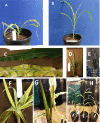Phenotypic effects from the expression of a deregulated AtGAD1 transgene and GABA pathway suppression mutants in maize
- PMID: 34871322
- PMCID: PMC8648116
- DOI: 10.1371/journal.pone.0259365
Phenotypic effects from the expression of a deregulated AtGAD1 transgene and GABA pathway suppression mutants in maize
Abstract
Glutamate decarboxylase (GAD; EC 4.1.1.15) catalyzes the irreversible decarboxylation of glutamate to produce γ-aminobutyric acid (GABA); a ubiquitous non-protein amino acid involved in the regulation of several aspects of plant metabolism and physiology. To study the function of GAD and GABA in maize, we have; 1) introduced native and deregulated forms of AtGAD1 into maize with the intent of increasing the synthesis of GABA and 2) introduced constructs into maize designed to suppress the activity of several GABA shunt, GABA transport and GABA pathway genes. Maize plants expressing the deregulated AtGAD1 exhibit a severe chlorosis and retarded growth phenotype and have high levels of GABA, and Ca++/CaM-independent GAD activity. Plants expressing the suppression constructs for GABA biosynthetic and transport pathway genes had no observable phenotype whereas a knockout of GABA catabolic pathway genes led to growth and developmental defects under standard growth conditions. The implications of this study to our understanding of the action and function of GABA and GAD in crops are discussed.
Conflict of interest statement
The authors have declared that no competing interests exist.
Figures







Similar articles
-
Glutamate decarboxylase-1 is essential for efficient acclimation of Arabidopsis thaliana to nutritional phosphorus deprivation.New Phytol. 2023 Dec;240(6):2372-2385. doi: 10.1111/nph.19300. Epub 2023 Oct 14. New Phytol. 2023. PMID: 37837235
-
Calmodulin binding to glutamate decarboxylase is required for regulation of glutamate and GABA metabolism and normal development in plants.EMBO J. 1996 Jun 17;15(12):2988-96. EMBO J. 1996. PMID: 8670800 Free PMC article.
-
Functional roles of the hexamer organization of plant glutamate decarboxylase.Biochim Biophys Acta. 2015 Sep;1854(9):1229-37. doi: 10.1016/j.bbapap.2015.01.001. Epub 2015 Jan 19. Biochim Biophys Acta. 2015. PMID: 25614413
-
A Brief Review on the Non-protein Amino Acid, Gamma-amino Butyric Acid (GABA): Its Production and Role in Microbes.Curr Microbiol. 2020 Apr;77(4):534-544. doi: 10.1007/s00284-019-01839-w. Epub 2019 Dec 16. Curr Microbiol. 2020. PMID: 31844936 Review.
-
Unraveling the Potential of γ-Aminobutyric Acid: Insights into Its Biosynthesis and Biotechnological Applications.Nutrients. 2024 Aug 19;16(16):2760. doi: 10.3390/nu16162760. Nutrients. 2024. PMID: 39203897 Free PMC article. Review.
Cited by
-
Transcriptomic Approach for Investigation of Solanum spp. Resistance upon Early-Stage Broomrape Parasitism.Curr Issues Mol Biol. 2024 Aug 18;46(8):9047-9073. doi: 10.3390/cimb46080535. Curr Issues Mol Biol. 2024. PMID: 39194752 Free PMC article.
-
Characterization of GABA-Transaminase Gene from Mulberry (Morus multicaulis) and Its Role in Salt Stress Tolerance.Genes (Basel). 2022 Mar 12;13(3):501. doi: 10.3390/genes13030501. Genes (Basel). 2022. PMID: 35328056 Free PMC article.
-
Cost-effective production of Escherichia coli "GABase" for spectrophotometric determination of γ-aminobutyrate (GABA) levels or glutamate decarboxylase activity.Biol Methods Protoc. 2025 Jun 20;10(1):bpaf050. doi: 10.1093/biomethods/bpaf050. eCollection 2025. Biol Methods Protoc. 2025. PMID: 40656557 Free PMC article.
References
-
- Mody J, Doninck Y, Otis TS, Soltesz I. (1994) Bridging the cleft at GABA synapses in the brain. Trends Nerosci, 17:517–525. - PubMed
-
- Shelp BJ, Bozzo GG, Trobache CP, Chiu G, Bajwa VS. (2012) Strategies and tools for studying the metabolism and function of γ-aminobutyrate in plants. I. Pathway Structure Bot, 90:781–793.
-
- Shelp BJ, Bown AW, Zarei A. (2017) 4-Aminobutyrate (GABA): a metabolite and signal with practical significance Bot, 95: 1015–1032.
MeSH terms
Substances
Associated data
LinkOut - more resources
Full Text Sources

